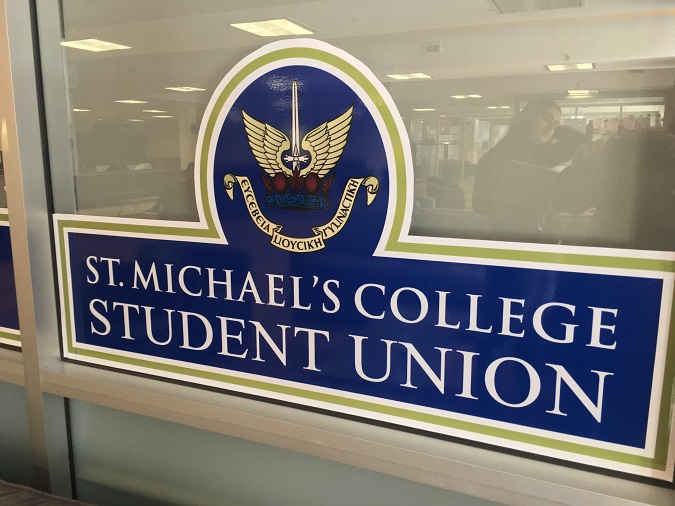Outlining some of the changes to SMCSU’s structure
Braedon Balko CONTRIBUTOR
In April 2017, the St. Michael’s College Student Union (SMCSU) released a report that advocates for a myriad of structural changes to the SMCSU. This came in response to the events of the last year, which culminated in the eventual prorogation of SMCSU. These amendments to the constitution come from student input via the “Re-Imagining Committee” and the “Re-Imagining Student Government Survey.”
The purpose of the committee and the survey was to see how University of St. Michael’s College (USMC) students want their student government to look like. It was found that, despite the diverse needs of a student body as large as the one at USMC, there were common themes that students wanted to see in their government. These included very broad needs such as transparency, communication, and accountability. Student responses varied widely in terms of their detail. Ultimately, it seemed that students wanted SMCSU to “function as a body to serve students through various programs and services” and to “reflect the diverse cultures and interests of St. Michael’s College students through every action.”
From this point of reference, USMC set out to reform SMCSU. While as of yet there have been no set amendments to SMCSU’s Constitution, the college has put out a list of changes to be implemented or considered for the new version that presumably is to come. This has broadly included rearranging the council’s structure, redefining their purpose, and creating the groundwork for holding SMCSU financially accountable.
The first significant change mentioned in the committee’s report is a major alteration to the roles of the Councillors on the SMCSU. The nine positions will henceforth be President, Vice-President, Vice-President Finance, Vice-President Communications, Vice-President Community Life, Vice-President Academic A airs, Vice-President Arts, Vice-President Athletics, and Vice-President Religious & Community Affairs (RCA). While the responsibilities of each position remain relatively intact compared to previous years, nearly all of the titles for the positions have been altered. Formerly, the term “Commissioner” was used to describe most of the positions, but this has been replaced with “Vice-President.” Much of the report seems focused on simplifying the roles set out in the Constitution, and it seems that this trend applies to the names of the positions themselves — and not simply through the use of Vice-President. For example, the Education and Government Commissioner has been renamed Vice-President Academic Affairs. Also, all former officer positions will hereafter be named Volunteer Officers.
Aside from modifications to SMCSU Commissioner titles, the report also details some changes to the responsibilities of the various councillors. Most notably, the 2016 roles of Community Life Commission and Double Blue Commission have been fused into a single Vice-President Community Life position. The Community Life Commission was formerly in charge of planning social events for the wider St. Michael’s College community, while the Double Blue Commission oversaw social activities for the members of the SMCSU themselves. The position of Vice-President Community Life will serve to streamline all SMCSU-planned social events and render the process of planning them more efficient.
The report also details changes to eligibility to run for office. Two major changes from the old constitution include a newly imposed minimum cumulative GPA of 2.5 and adherence to a Code of Conduct that is currently being developed. Additionally, a new requirement stipulates that all those vying for a position in the council must have either have formerly held a position in the council or have volunteered on an SMCSU committee in the past.
Major changes have also been made to how the council will run as a whole. These are outlined in the Re-Imagining Committee’s report on SMCSU’s new structure and guidelines. The changes are highlighted by mandatory leadership training for council members, public presentations outlining SMCSU’s budget in the fall and spring, imposing term limits on council members, and requiring the USMC Administrative Advisor to co-sign on any expenses over $500.
Perhaps the biggest changes will come to Article III of the Constitution, which deals with accountability. This part of the current Constitution is incredibly vague. Most of Article III focuses on how to vote out a member of the council. On transparency the Constitution states only, “All financial records, budgets, general correspondence, and the minutes of Council meetings […] shall be open for review by any member of the Student Union.”
This has in turn been one of the USMC administration’s main focuses. In a statement on re-imagining student government posted on the USMC website, USMC President David Mulroney highlights “evidence of wrong-doing by some of our student leaders in a pattern that goes back a decade or more.”
This has brought to the fore questions of how autonomous SMCSU will remain from USMC, which have in part been addressed by USMC’s recently introduced Policy Document for Student Societies at USMC. Student societies to whom it applies include SMCSU, The St. Michael’s Residence Council (SMRC), and The Mike.
“The actions of student societies have the potential of reflecting, both positively and negatively, on the name and reputation of USMC,” the document reads. “Although USMC affirms that student societies are self-governing, it also recognizes that it has an ethical obligation to hold these societies accountable for the activities they seek to hold in USMC’s name.”
The consensus appears to be that in order to avoid the mistakes of the past SMCSU, USMC needs to implement change. The extent to which new policy will be introduced and enforced, however, remains unclear.



